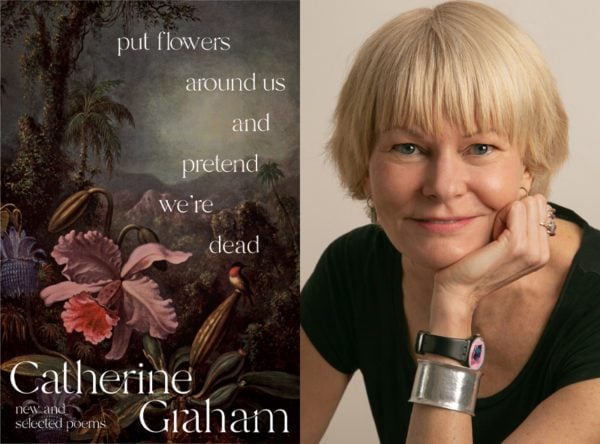
Catherine Graham (Marion Voysey)
If Catherine Graham’s parents had not died while she was in university she might never have become a poet.
It was Graham’s attempt to process the loss of her mother to cancer and the death of her father in a car accident a few years later that pushed her in the direction of poetry. Just out of university, Graham was already undergoing therapy to work through her grief – her mother died on Christmas Day; her father’s autopsy showed that he was three times over the legal blood-alcohol limit when he crashed the car he was driving (a passenger survived the accident). But therapy proved insufficient as an outlet for her roiling emotions.
“The therapist suggested I keep a journal to write things out and to have some kind of relationship with the grief,” Graham says. “There was one day that I veered off and went into this space of imagery and music and I came out and thought, ‘What happened there?’”
Graham, a self-professed introvert, worked up the courage to show a family friend what she had written, and the response was revelatory: “She said, ‘This is poetry.’”
To call the moment a turning point, Graham suggests, is too limiting in terms of the life-altering recognition it entailed. “That was the key moment, and then there was no turning back,” she says. “I knew that I wanted this to be the core of my life.”
The result has been bountiful: six previous collections, including 2021’s hybrid volume of poetry and memoir, Æther: An Out-of-Body Lyric, which Graham’s long-time editor Paul Vermeersch suggests contains “many of the keys to unlock the doors” in Graham’s verse. In this way, Æther makes a suitable companion volume to Graham’s latest, Put Flowers Around Us and Pretend We’re Dead: New and Selected Poems. Published by Buckrider Books, an imprint of Hamilton, Ontario, publisher Wolsak & Wynn, the book contains poems from each of Graham’s full-length collections save for Æther (it also leaves out her debut chapbook, The Watch, from 1998) along with a generous helping of new work.
What is most remarkable about reading the poems from different stages in Graham’s career is their consistency: not so much in terms of style, though they are mostly short (Graham jokes that for her, a long poem is one that makes its reader turn the page). In addition to the relative length of the poems, certain metaphors and images crop up repeatedly; moths and birds and dolls reappear across various poems, as does the ubiquitous image of a quarry, something that has haunted Graham’s literary imagination. (The word even serves as the title of Graham’s 2017 debut novel.)
The quarry embedded itself in Graham’s consciousness before she ever became a poet. She grew up in a house in Ridgeway, Ontario, on a plot of land that had a quarry hidden by a copse of trees. “You wouldn’t see it from the road,” Graham says. “I think that added to the sense of mystery. I had to walk up a long driveway and then turn to see it; you had to curve around and then it would reveal itself.”
Looking back, she identifies the idea of a blasted landscape as a kind of unconscious, even Jungian approach to grief and grieving. The quarry’s makeup of limestone and water also adds an element of life and history that is reflective of Graham’s attitude toward the nature of her poetic expression. “Water holds life, but it’s also holding what’s hidden,” she says. “The fluidity of water and the hardness of rock, but at the same time, limestone is full of all those layers of lost animal [fossils] – I feel like it’s just an image for poetry.”
Graham admits that she never planned to have the quarry follow her throughout her career, but she has learned with time not to question its recurrence and to give herself over to it if it seems appropriate to her writing. She is similarly conscious of the way one poem or group of poems will lead almost organically to the next and how one book will blend into another over the course of a career.
If the consistent imagery is one obvious element in the new volume, what is equally apparent is a move away from a relatively straightforward approach to her subject matter in favour of something more abstract and implicative in the later poems. Part of this, Graham says, has to do with a shift in her poetic practice that includes the incorporation of lines and images that appear to her in dreams. In the last few years, she has made a habit of keeping a notebook next to her bed, in which she jots down the “dream lines” that sometimes make their way into her work. (The title of the new collection is one of those dream lines.) “It’s strange to be working with the material in such a way,” she says. “I think that has added to the sense of the poems being more elliptical and associative and not as direct.”
The change in approach notwithstanding, Graham feels the appearance of this new and selected volume represents not so much an ending as one stage in an ongoing conversation with herself and her readers. “All of the writing, in some ways, is just a thread that continues.”
Whatever direction Graham takes next, she remains as committed to the project of poetry as she was in that revelatory moment when she realized the musical, imagistic writing she was doing for therapy was more than simple journaling. “Poetry will always remain alive. It’s essential, all cultures have it,” she says. “We want something that matters. Words in the right place and the right order. How important that is to hang on to in moments of intense pain or intense joy.”

 Contact us via email
Contact us via email
